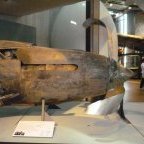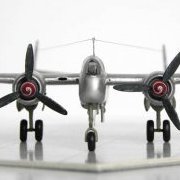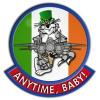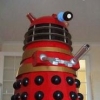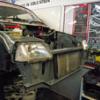Search the Community
Showing results for tags 'luft46'.
-
Arado Ar.E.555 P-Series (03790) 1:72 Carrera Revell Whilst riding high on their seemingly unstoppable campaign to take over the world, Adolf Hitler instigated an Amerika Bomber project, to produce a bomber that was capable of taking the fight across the Atlantic Ocean t...
-
We reviewed this puppy mid February, and as I'm a sucker for a late war jet, I dug in straight away to see what I could do with it. As I said in my review, it's not a shake-and-bake kit, so you'll definitely have to apply some of those fabled modelling skills to building it. If you're the type to...
-
Hi guys! I plan (if everything goes smoothly) on getting Tamiya's He 219A-7. Box schemes are fairly dull, black over light blue or the latter colour covering the entire aircraft. Since the He 219, for me, borders Luft 46, I would like to get some inspiration for a whiffer camouflage....
-
Messerschmitt Me.262 HG.III (48A003) 1:48 Amusing Hobby via Albion Alloys The Me.262 was a ground-breaking aircraft, as it was the world’s first fully operational jet-powered fighter that went into action too late to make any real difference to the outcome of WWII thank...
-
Hello guys, Here are the photos of my most recently completed model, the Me P.1099 from Revell Germany in 1:72.
- 7 replies
-
- 8
-

-
- messerschmitt
- Revell
-
(and 1 more)
Tagged with:
-
After finishing my Spitfire, I decided to build this little kit that I found at Hobbies Moròn for a good price. Only three sprues inside the medium sized box, two in dark green and one clear sprue. Instructions are of the pre-2017 Revell style, I.E a photocopy with very clear...
- 10 replies
-
- 3
-

-
- messerschmitt
- luft46
-
(and 1 more)
Tagged with:
-
Here is my Revell 1:72 Messerschmitt P.1100 I built back in 2009. It represents Messerschmitt P.1100 "Red 2", Wk Nr 700831, of KG54, Luftwaffe, in 1945 (fictitious). Revell released this as a P.1099 but that is incorrect since the P.1099 had the engines moved back due to the centre...
- 11 replies
-
- 25
-

-
Ladies and Gents Having had an interest in Luft46 aircraft with the amazing concepts what better opportunity to bring them all together in one place with a dedicated Group Build. So what I hear you say is Panzer46 ? This is the AFV equivalent something that until...
-
Hi all and sorry for not posting here sooner! Recently finished for a 'What If' GB - the full build thread is here but to recap: Kit: 1/72 PM Models Ta-183 Build: Mostly OOB Extras: Tape for belts and some plasticard in the u/c bays. Cut the one-part canopy open Paints: Reve...
-
During the recent Blitzenbuild over the Christmas period, given that you only have 24 hours in which to start and finish it, but spread over 3 days, I chose to do the PM Ta183. The build thread is below If you haven't taken part in a Group Build before, I throughly re...
-

Brengun Messerschmitt P.1103b Volkjager Candidate 1:48
Mike posted a topic in Work in Progress - Aircraft
I saw a new member (I think?) showing off his finished example the other day, and you know what a sucker for silly and unusual things I am. I picked one in 1:48 up from Brengun off eBay for as cheap as Cheapo McChips, and treated it to a PE set from the same brand because that cockpit with be SO vi... -
A fun project from beginning to end, only watered down because the weights in the nose got lose. It was brush painted in RLM 79/70/65. I still have to come up with an interesting Luft 46 story.
-
This is my entry to the recent Blitzbuild Group Build. The kit is nice a simple, ideal when you only have 24 hours to complete the entire build ! The work in progress is below As the decals that come with the kit and the proposed colour scheme wasn't very inspiring I decided...
-
This kit was built during the "Blitzbuild Group Build" here on BM recently, for those unfamiliar this is where an attempt is made to start and finish a kit over the bank holiday weekend either in two 12 hour sessions or in one mammoth 24 hour session. With photos with time and date proof to show you...
-
Scratchaeronautics is to release a 1/72nd Junkers unnamed ground attack project (Luft 46) resin kit Source: https://www.facebook.com/Scratchaeronautics/posts/1472262192806833 Preorder: http://www.ebay.co.uk/itm/JUNKERS-GROUND-ATTACK-PROJECT-RESIN-1-72ND-SCALE-/252798865471?hash=item...
- 1 reply
-
- 1
-

-
- Junkers
- Scratchaeronautics
-
(and 1 more)
Tagged with:
-
I finished this yesterday so here is the promised RFI. Here is the build thread. I thought this was going to be an almost out of the box build but in the end I added or modified the following: Modified the front undercarriage strut and made it so it could be added later on in the build. Added PE s...
- 34 replies
-
- 38
-

-
- Nigey Build
- Luft46
-
(and 1 more)
Tagged with:
-
This is my next project: The kit consists of two grey sprues: Although it says Revell on the sprues, this was originally released by Dragon in 1993. Some of the gates are quite thick but it does feature very nice engraved panel lines:...
-
This is my new Luft 46 attempt. The kit from AZmodel is a typical modern short run one. Built OOB except for some elements in the cockpit, which are almost not visible. I've also added a twin underbelly 30-mm cannon and triple BR21 launchers under each wing from my spare parts box. This big heavy fi...
-
Here's another recent build, the Revell Ho229 (not Go229 as mislabelled on the packaging). More or less straight from the box, but with the inaccurate side panels removed from the cockpit bathtub, the voids underneath the exhausts filled and the Airwaves and Eduard photo etch sets employed to add de...
-
Ok it looks like I'm starting... well finishing a project/build I started about 15 years ago. Thanks to Nigel’s inspiration I’ve finally decided to drag this old beast out....was planning the build the Skyshark, but this’ll now have to wait a bit. As said this was started many years ago, but stall...
- 6 replies
-
- 2
-

-
- Plant Models
- Gotha
-
(and 2 more)
Tagged with:
-
Hello everyone, This is my first "Luft46" model, not a bad little model. Had some trouble with the nose fitting, but over all I am happy with it. Towards the end of the build I was rushing it to get it done. All painted using the hairystick. Hope you like it! Let...
-
Hi, all I have noticed a lack of this model on forums so I thought I'd give it a go whilst I decal some Spifires. Also worth mentioning is the fact that the parts aren't numbered on the sprew, this lead me to having to keep referring to the instructions for any multiple parts to make sure th...
-
Hi all, The Bachem's finally ready. Build thread is here: http://www.britmodeller.com/forums/index.php?/topic/234937749-brengun-172-bachem-ba-349a-natter/ Colours are as follows: RLM 76 - Revell 49 + 05 (4:1) RLM 75 - Revell 74 + 05 (4:1) RLM 74 - Revell 39 + 79 (2:1) RLM 66 - Revell 77 RLM...


